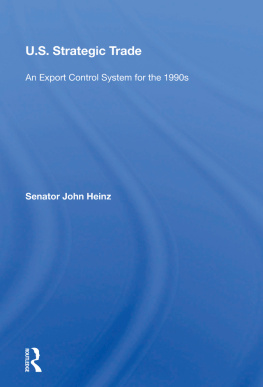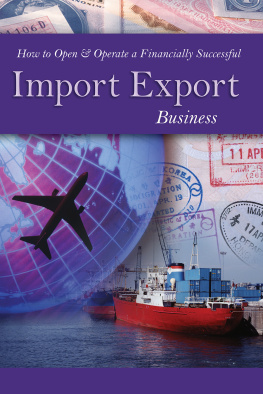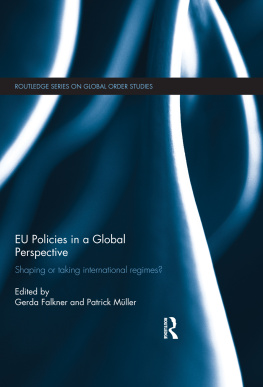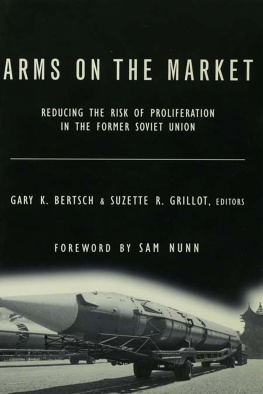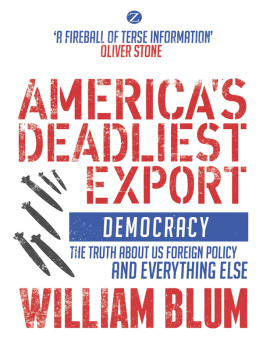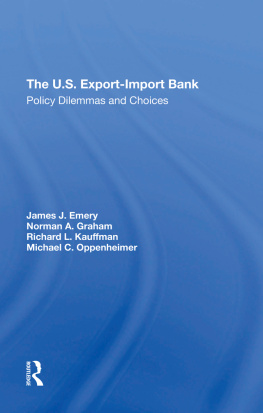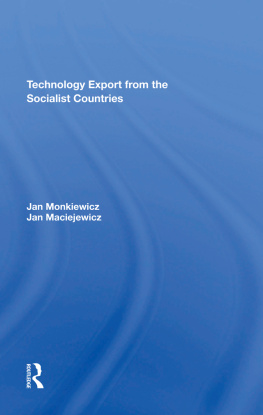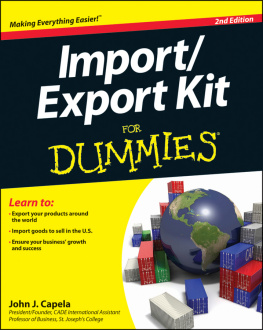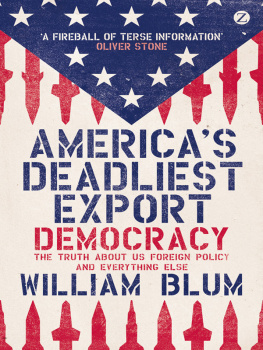U S. Strategic Trade
U.S. Strategic Trade
An Export Control System for the 1990s
Senator John Heinz
First published 1991 by Westview Press
Published 2018 by Routledge
52 Vanderbilt Avenue, New York, NY 10017
2 Park Square, Milton Park, Abingdon, Oxon OX14 4RN
Routledge is an imprint of the Taylor & Francis Group, an informa business
Copyright 1991 by Taylor & Francis
All rights reserved. No part of this book may be reprinted or reproduced or utilised in any form or by any electronic, mechanical, or other means, now known or hereafter invented, including photocopying and recording, or in any information storage or retrieval system, without permission in writing from the publishers.
Notice:
Product or corporate names may be trademarks or registered trademarks, and are used only for identification and explanation without intent to infringe.
Library of Congress Cataloging-in-Publication Data
Heinz, John, 1938
U.S. strategic trade: an export control system for the 1990s /
John Heinz.
p. cm.
Includes bibliographical references and index.
ISBN 0-8133-8126-6
1. Export controls--United States. 2. United States--Commercial
policy. 3. National security-United States. 4. Foreign trade
regulation--United States. I. Title.
HF1414.5.H45 1991
382'.64'0973--dc20 90-21889
CIP
ISBN 13: 978-0-367-21237-7 (hbk)
Senator John Heinz (R-PA) has long been recognized as one of the most knowledgeable members of Congress on the subject of the U.S. export control system. In this timely book the senator once again demonstrates his scholarship and encyclopedic comprehension of this subject as he presents a thorough review of U.S. and allied export control policies since World War II. The study presents a clear, historical perspective of how we got into the bureaucratic logjam we are in today, but it also lays out a blueprint for how we might reorganize the government in order to extricate ourselves.
In 1979, in 1985, and again in 1989, Senator Heinz played a leading role in legislating reforms of the export administration system. As the chief staff member of his Banking Subcommittee on International Finance and Monetary Policy and later as the assistant secretary for trade policy and as the under secretary for export administration in the Commerce Department, I can also attest to the impact of the reform amendments Senator Heinz authored. For example, as a result of the tougher criteria and findings he was able to legislate in the area of foreign policy controls, the administration decided not to use such sanctions as a first option in response to a number of foreign policy crisis situations. Instead, policymakers utilized other means of expressing U.S. government disapproval of other countries' behavior or policies, thus avoiding actions that might further damage the reputation of the United States as a reliable supplier of goods and services. I can attest to the fact that the foreign availability function began to play a more effective role in decontrolling goods kept far beyond their useful lives as strategic items because of reforms set in motion by Senator Heinz in the 1985 amendments to the Export Administration Act.
Obviously, however, much remains to be done. Although foreign availability succeeded in finally decontrolling items such as the 80286-based microcomputer, the system remains gridlocked on other foreign availability decisions and in many other areas, such as commodity jurisdiction disputes between the Commerce Department and the Departments of State and Defense.
Unlike many books about Washington that provide critiques of what is wrong but offer no solutions to set things right, this study provides a practical plan for the reorganization of the export control function now spread among the Departments of Commerce, Defense, and State. Senator Heinz presents a compelling argument for elevating export administration to a new, higher role as a key element in U.S. defense and foreign policy and then goes on to argue that such an elevation and consolidation would provide the prompt and decisive answers to licensing requests that U.S. exporters need and deserve. With export licensing accounting for more than $100 billion in U.S. trade in 1989 and with it likely to continue to be needed for tens of billions of dollars in trade for the immediate future, our nation can afford no lesser system.
If it is true that the Cold War is over and that the United States has won it, as President Ronald Reagan is reported to have said on his trip back from the Reykjavik, Iceland, summit meeting, then it is appropriate to give at least partial credit for that victory to the part played by the Coordinating Committee for Multilateral Export Controls and the export control system that has been in place since 1949. The question remains, however, whether the cost of that victory is higher than it might have been under an alternative strategy and whether that cost, in terms of delay and confusion, must be continued into the future. Senator Heinz addresses this question, considering how we can best organize ourselves to reap the fruits of that victory and to maintain the peace through technological security. The challenge is to accomplish all this while at the same time ensuring our nation's economic competitiveness.
To govern is to choose, and no decision is more important to our survival and our success as a nation than the balance that must be struck between national security and economic prosperity. In this book Senator Heinz provides a practical and understandable blueprint for helping our nation's decisionmakers achieve that compromise.
Paul Freedenberg
I like the dream of the future better than the history of the past.
Thomas Jefferson
The genesis of this book dates back to June 1989, when I was invited by the Center for Strategic and International Studies to speak before a forum on East-West economics. I was asked to address two themes: the pressures from allies and industry to narrow export controls to the Soviet bloc, and the impact of Soviet President and Party Secretary-General Mikhail Gorbachev's reform movement on U.S. export control policy toward the Soviet bloc.
The invitation fortuitously dovetailed with a decision Senator Jake Gam (R-UT) and I had reached earlier in the year to introduce a bill to reform the U.S. export control system. Since 1977 I have had a role in nurturing the growth of the current U.S. national security export control system, at various times as chairman or ranking member of the Subcommittee on International Finance and Monetary Policy of the Senate Banking Committee that oversees export controls. I particularly remember the contentious times surrounding the reauthorization of the Export Administration Act of 1979 and its subsequent reauthorizations in 1983 and 1985 and the 1988 Trade Bill.
When it comes to the U.S. national security export control system, I cannot help but identify with Thomas Jefferson's remark. I will be among the first to admit that the system, with its long history of tortuous growth and anachronistic policies and appendages, must be reformed if the United States is to avoid the problems of the past. For this reason, Senator Garn and I introduced a bill, the Export Administration Act of 1990, which had as its centerpiece the creation of the Office of Strategic Trade and Technology (OSTT-hereafter, the OSTT Bill). The OSTT Bill would create a new national security export control system to make sweeping changes in the process by which our nation arrives at decisions on export controls and technology matters. The organizational structure and policy changes in the OSTT Bill are discussed in of this book.

